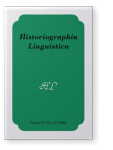Vol. 27:2/3 (2000) ► pp.379–414
Seven grammarians on the ‘ablativus absolutus’
In this article, the history of the so-called ablative absolute as a descriptive category is traced from the 3rd to the 20th century. Texts by Sacerdos, Diomedes, Priscian, Alberic of Montecassino, Kühner & Stegmann and Harm Pinkster illustrate how the ablative absolute is recognized long before it get its name, and how its role in grammatical description is invented, changes, and disappears again in accordance with the grammatical systems adopted by the respective grammarians. The ablative absolute starts as a kind of appendix to the doctrine of the parts of speech, is moved from the description of the noun to that of the participle, and eventually just fades away as a descriptive label in its own right in the context of Functional Grammar. Its history cannot, of course, prove that the ‘God’s Truth’ metaphysics of grammar is wrong, but it certainly looks like a series of manifestations of grammatical ‘Hocus Pocus’.
